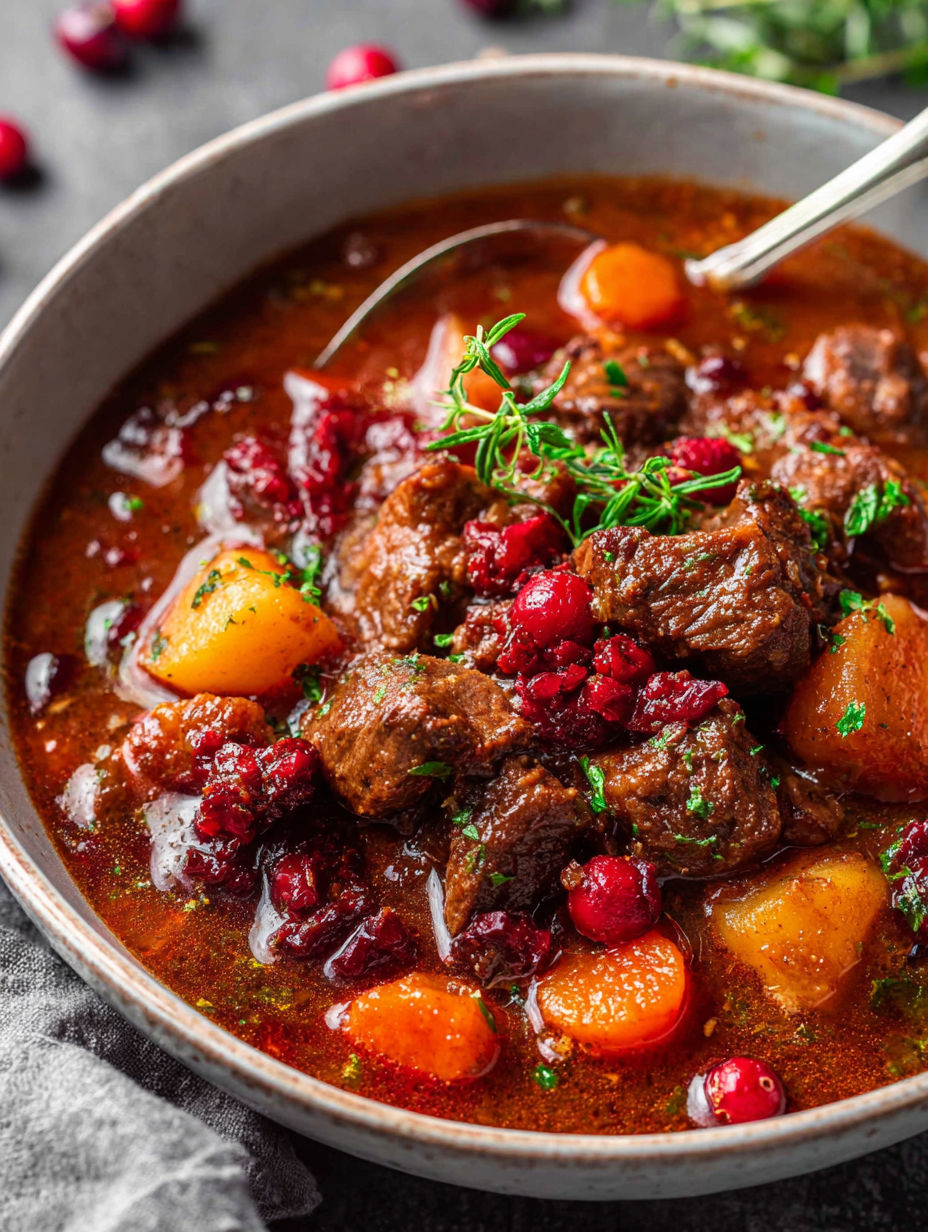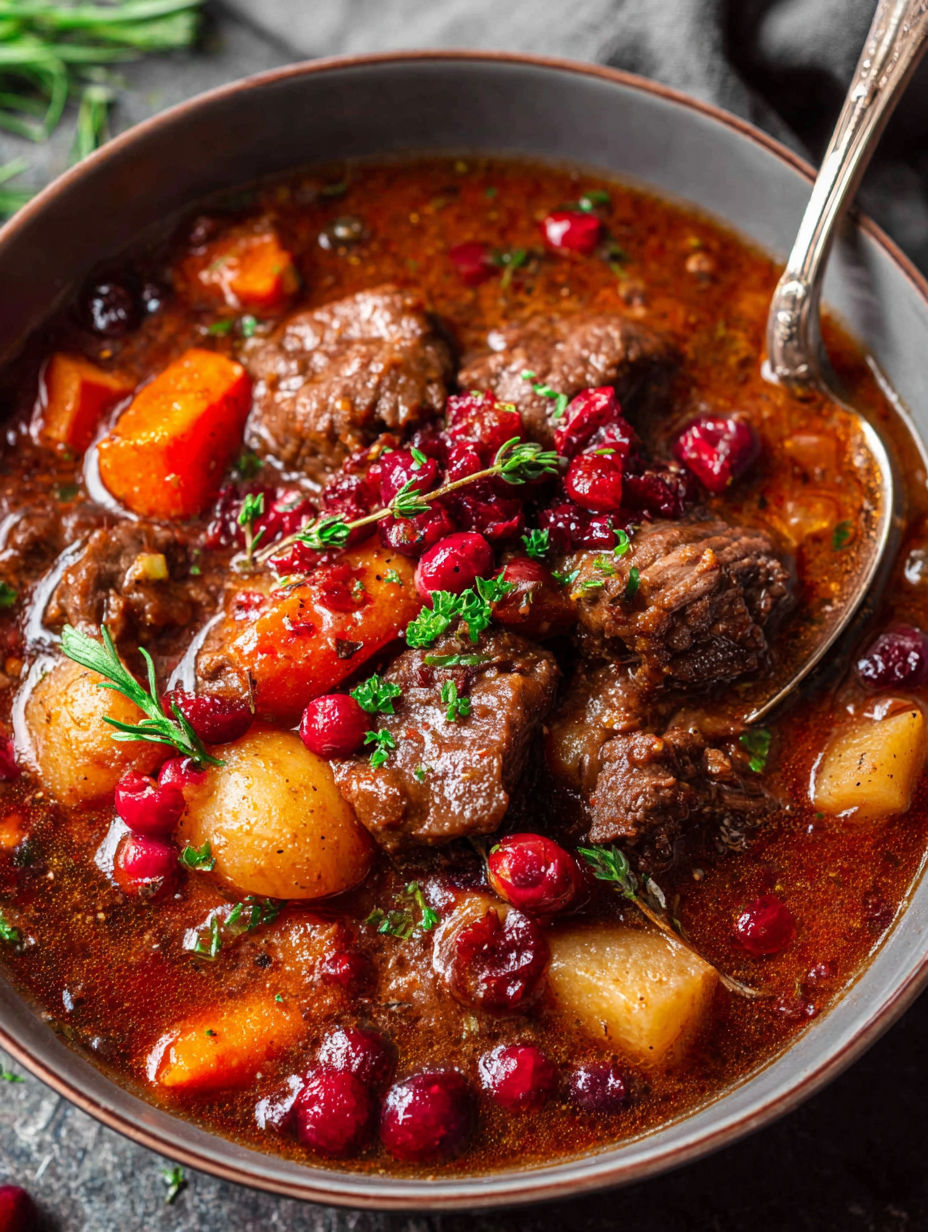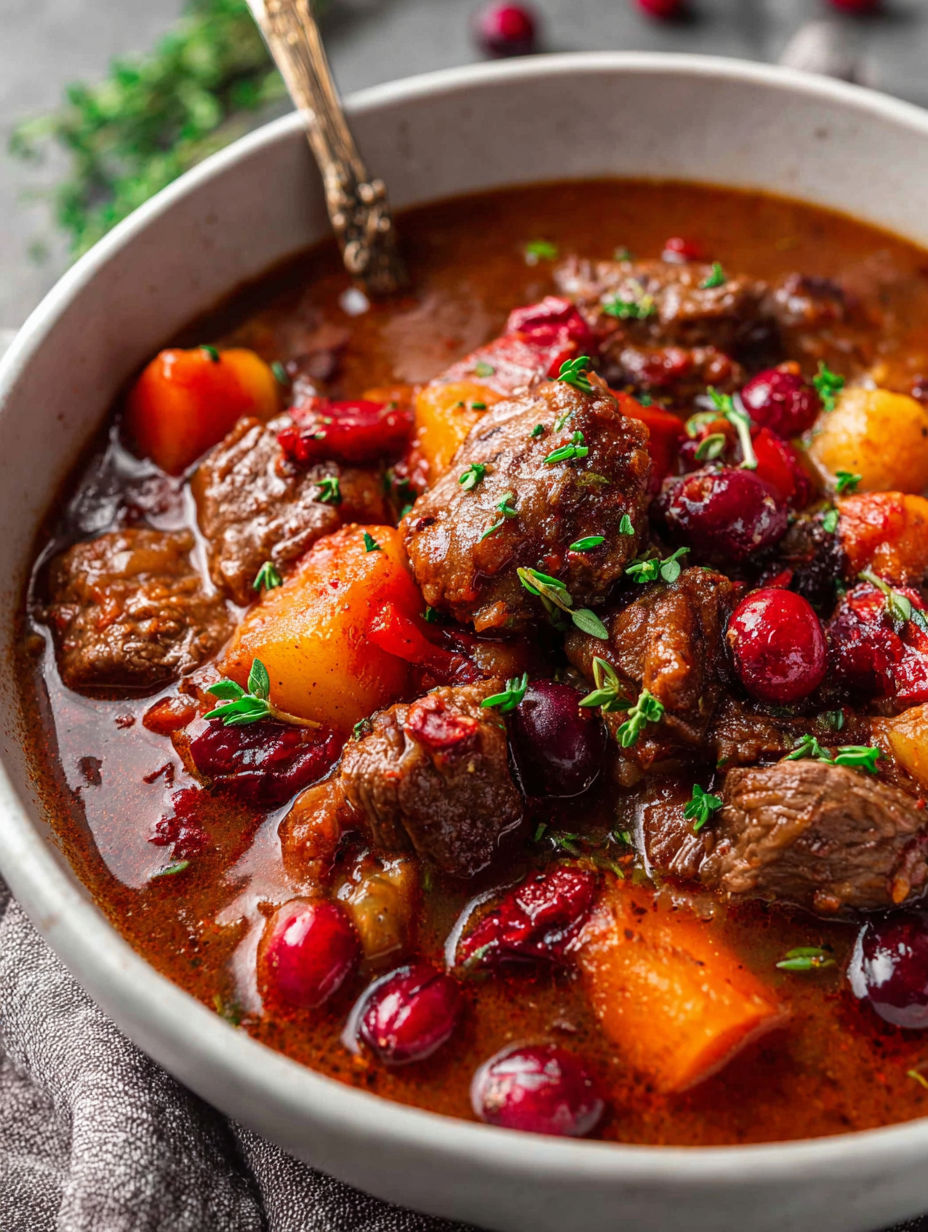 Save
Save
This cranberry apple beef stew brings a cozy touch to dinner with its perfect blend of sweet and savory. It’s my favorite when I want something filling that feels a bit special without taking forever to prepare. The bright tartness from cranberries and apples pairs beautifully with tender beef for a stew that warms you right up.
I first made this after spotting fresh cranberries at the store and it quickly became a staple for chilly evenings. The flavors came together so well that I found myself craving it again and again.
Ingredients
- Beef chuck roast: cut into one inch pieces for tender meat that absorbs flavors well
- All-purpose flour: with seasoning helps create a rich crust and thickens the stew naturally
- Olive oil: for a good sear, choose extra virgin for a more robust flavor
- Tomato paste: adds concentrated savory depth, look for cans without additives
- Red wine or red wine vinegar: introduces acidity depending on your preference for a fruity or tangy note
- Yellow onion: brings natural sweetness and complexity, select firm and bright bulbs
- Celery: for freshness and subtle bitterness that balances richness
- Garlic: for aromatic warmth, always go with fresh cloves over pre-minced
- Carrots and Yukon gold potatoes: for hearty texture, no need to peel potatoes as their skin holds nutrients and softens nicely
- Granny Smith apple: adds crisp tartness, choose firm apples with good color for best flavor
- Worcestershire sauce: intensifies the umami notes, pick a reputable brand for authentic taste
- Apple cider: introduces a light fruity sweetness and richness in the broth
- Beef broth: as the stew base, homemade or low sodium store-bought for control over saltiness
- Bay leaves: to infuse gentle herbal fragrance
- Fresh sage: to complement the fruit and meat, select crisp leaves without discoloration
- Fresh or frozen cranberries: to brighten the stew at the end, fresh if in season, frozen works well and is convenient
- Fresh parsley: for garnish and a green fresh finish
Instructions
- Build The Base:
- In a heavy bottomed pot or dutch oven, heat olive oil over medium high heat until shimmering. Toss the beef pieces with seasoned flour and add them to the pot. Let the beef brown undisturbed for about two minutes before stirring to develop a good crust all around. This step seals in juices and builds a deep flavor. Continue cooking until all sides are browned, about ten minutes total.
- Add Tomato Paste And Deglaze:
- Stir in tomato paste coating the meat and vegetables. Cook for two minutes to caramelize slightly and deepen the flavor. Pour in the red wine or vinegar and cook for two more minutes, scraping the bottom of the pot to lift all those tasty browned bits.
- Sauté Vegetables:
- Add diced onion, celery and minced garlic to the pot. Stir frequently and cook for three to four minutes until the onion is translucent and softened. This stage builds a fragrant base that supports the stew’s flavor layers.
- Combine Remaining Ingredients:
- Pour in the carrots, potatoes, apple, Worcestershire sauce, apple cider, beef broth, and add the bay leaves. Stir to mix everything evenly. Bring the stew to a boil, then reduce the heat to a simmer, cover with a lid and cook gently for at least one hour or until the beef is tender and breaks apart easily with a fork.
- Finish With Fresh Herbs And Cranberries:
- Stir in chopped fresh sage and cranberries. Let cook uncovered for an additional ten minutes to soften the fruit and marry the flavors. Taste and adjust salt and pepper as needed.
- Serve With Fresh Parsley:
- Spoon the stew into bowls and garnish with roughly chopped fresh parsley and any remaining sage leaves for a burst of color and fresh herbal notes.

My favorite part is adding the sage and cranberries near the end which really elevates the dish and brings back memories of cozy family dinners around the table during autumn.
Storage Tips
Store leftovers in an airtight container in the refrigerator for up to four days. The stew tastes even better the next day once the flavors have melded. To reheat, warm gently on the stove or microwave until just heated through to avoid overcooking the beef.
Ingredient Swaps
If you don&t have red wine, substitute with extra beef broth plus a splash of balsamic vinegar for acidity. You can replace Granny Smith apples with another tart apple variety like Honeycrisp. Frozen cranberries can be swapped for fresh if in season or even dried cranberries added near the end but reduce any additional sugar in the recipe if you do so.
Serving Ideas
Serve over creamy mashed potatoes or buttered egg noodles to soak up all the rich juices. A crusty bread alongside is perfect for mopping up the stew. For a lighter meal, enjoy this with a simple green salad tossed in a vinaigrette.
Cultural Context
Beef stew is a classic comfort food across many cultures, enjoyed in countless variations. The use of tart fruit in meat dishes has roots in Northern European and American cooking traditions where local harvests influence flavors. This particular cranberry apple combo brings a seasonal New England flair to a familiar favorite.

Cranberry Apple Beef Stew is a choice I make when I want dinner to feel homey yet a little different. The balance of fruit and savory makes it not just filling but memorable. I learned early on that browning the beef well and not rushing the simmering really delivers the best depth and tenderness.
Frequently Asked Recipe Questions
- → Can I use a slow cooker for this dish?
Yes, you can cook the stew on low for 6-8 hours in a slow cooker for tender beef and melded flavors.
- → What cut of beef works best?
Beef chuck roast cut into 1-inch pieces is ideal for slow cooking and becomes tender while absorbing flavors.
- → How do the apples affect the flavor?
Granny Smith apples add a bright sweetness that balances the tart cranberries and savory components.
- → Can I thicken the stew?
For a thicker texture, whisk cornstarch with cold water and stir into the stew during the final cooking minutes.
- → Is it necessary to peel the potatoes?
No, Yukon gold potatoes can be used unpeeled for added texture and nutrients.
- → What herbs complement the stew?
Fresh sage is stirred in near the end, and parsley is used as garnish to add fresh herbal notes.
